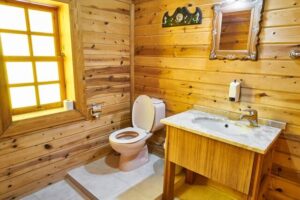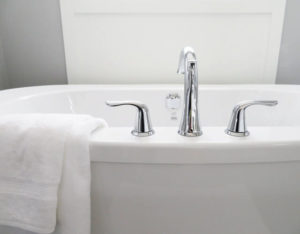In an emergency, you want to know that you can rely on your plumber to get the job done. A good plumber knows what to do—and how to do it fast—during a plumbing emergency. What is a plumbing emergency? Keep reading to learn when you should call a plumbing expert ASAP. As the name suggests, a plumbing emergency is an incident during which the plumbing in your home or business malfunctions, often causing serious damage, or at least having the potential to cause it. It does not take long for a little bit of water to do a lot of damage to a building’s flooring, walls, ceilings, and even foundation. A plumbing emergency usually has a few distinct characteristics: Water is leaking from an undefined source. Water is coming from a visible source but can’t be stopped without professional help. The leaking water has caused or has the potential to cause extensive damage. Hazardous waste or materials are present. Your basement doesn’t need to be flooded to warrant a call to an emergency plumber. What is a plumbing emergency? These four examples answer this critical question. Leaking or Burst Pipes Leaky pipes are one of the most common examples of … Continue reading What Is a Plumbing Emergency? 4 Examples that You Never Want to Experience

How to Test Water Pressure in Your House: Everything You Need to Get Started
When was the last time you tested your home’s water pressure? Never? If you have given little to no thought to learning how to test water pressure in your house, you might want to reconsider. Here is what you need to know. Too much water pressure and you could damage your plumbing. Too little and you can’t take a comfortable shower. In some cases, you may not even realize that your pressure is not what it should be, but that problem is easily fixable with a few simple steps. If you have ever wondered how to test water pressure in your house, these tips are for you. The Shower/Toilet Test Have you ever noticed how the water pressure changes while you are showering when someone else flushes a toilet? If you have, you might want to take a closer look. Turn on your shower and watch what happens when you flush the toilet. Does the pressure drop significantly while the toilet is refilling? If so, it might be time to call a plumber to diagnose the problem. Buy a Pressure Gauge If you do not notice anything when you try the shower/toilet test but you still suspect you have a … Continue reading How to Test Water Pressure in Your House: Everything You Need to Get Started

3 Simple Ways to Avoid a Sewer Backup and Save Your Home from Going Down the Toilet
What goes down must not come up! If you want to avoid the mess of a sewer backup, these tips are for you. Whether you are doing laundry or using the toilet, the last thing you want to happen is for whatever you are sending down the drain to come back into your home. You don’t need an active imagination to picture what that would look like—just think of the damage to your carpets and hardwood flooring! Fortunately, you have a chance to stop that from happening if you know the signs. Use these tips to avoid a major sewer backup. Don’t Ignore That Bad Smell Do your drains smell like sewage? That’s one of the signs that you have a possible sewer backup on your hands. When a drain gets clogged, whether from roots invading your main line or from something that just got stuck, the material that gets stuck in the pipes decomposes, which produces a foul smell. It is possible that the smell is coming from a clog that is isolated to a single drain, but if conventional methods of clearing the blocked drain do not work, calling a plumber might be necessary to determine whether the … Continue reading 3 Simple Ways to Avoid a Sewer Backup and Save Your Home from Going Down the Toilet

Need Water Leak Repair for Hot Water Heater? Here’s What You Should Do
A water leak in your hot water heater is never fun and always inconvenient, no matter if the leak is a trickle or a deluge. Even if it does not seem very bad, you should schedule a water leak repair. Do you know what to do if your hot water heater is leaking? If not, you could be facing massive water damage—and hundreds or thousands of dollars in repairs—in the near future. If you want to be ready in case you experience a leak in your water heater, keep reading until the end of this article. Turn off the Water Supply When you notice water coming from your water heater and pooling on the floor, the first thing you need to do is turn off the water supply. Your water heater should have a shutoff valve attached to it. Inspect your water heater near where the cold water enters it. Once you find the valve, turn it off. Some valves are shaped like a wheel. If that is the case for your water heater, turn it to the right until it stops moving. Other valves are shaped like handles, in which case turn yours 90 degrees from the position it … Continue reading Need Water Leak Repair for Hot Water Heater? Here’s What You Should Do

Do You Know What to Do in a Plumbing Emergency? 3 Critical Steps to Take ASAP
If you have ever experienced a plumbing emergency, you probably never want to go through it again. Unfortunately, most homeowners have to deal with it at least once. The good news is, there are some simple steps that you can take to limit the damage to your home, possibly save some money, and fix the problem. Ready to fix your plumbing problem before it leaves you wet and angry? Here are three steps to take ASAP. Shut Off the Water Supply before the Plumbing Emergency Gets Worse It is easy to panic when water is flowing into your home at an enormous rate, but stay calm—the only way out of this is through. If your emergency is some sort of major leak or burst pipe, the first step you need to take is to turn off the water supply. Depending on where the leak is taking place, you have a few options to prevent further damage from happening. If the leak is happening in a water fixture like a toilet or a sink, you may be able to shut down the nearby emergency valve. Check behind the toilet or under the sink and turn the knobs until the water stops. … Continue reading Do You Know What to Do in a Plumbing Emergency? 3 Critical Steps to Take ASAP

